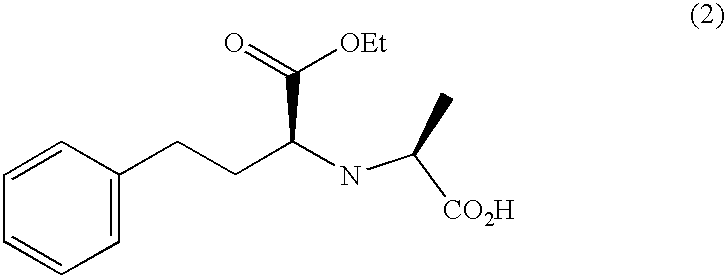Methods for crystallization of n-(1(s)-ethoxycarbonyl-3-phenylpropyl)-l-alanine n-carboxyanhydride
a technology of n-carboxyanhydride and crystallization method, which is applied in the field of crystallization of n-carboxyanhydride n(1 (s)ethoxycarbonyl3phenylpropyl)lalanine, can solve the problems of inconvenience in the handling of this versatile intermediate compound, inability to remove concomitant impurities, and inability to us
- Summary
- Abstract
- Description
- Claims
- Application Information
AI Technical Summary
Benefits of technology
Problems solved by technology
Method used
Image
Examples
example 2
[0079] A solution of N-(1(S)-ethoxycarbonyl-3-phenylpropyl)-L-alanine N-carboxylic anhydride in dichloromethane as prepared by the procedure according to the preparation example of a solution in a good solvent, 63.2 g (62 wt. % concentration), was added to 250 ml of normal hexane over 30 minutes at 45.degree. C. and the mixture was stirred at the same temperature for 30 minutes. Then, the mixture was further cooled to 5.degree. C. over 4 hours and stirred at the same temperature for 1 hour (the weight ratio of good solvent / aliphatic hydrocarbon solvent was 0.15). The precipitated crystals of N-(1(S)-ethoxycarbonyl-3-phenylpropyl-)-L-alanine N-carboxylic anhydride were collected by suction filtration using a Buchner funnel and washed with 100 ml of normal hexane. After filtration, the scale adherent on the vessel wall was separately dried and its amount was confirmed to be about 8 weight % of the total amount. Substantially no oil formation occurred. The wet crystals obtained were dr...
example 3
[0080] A solution of N-(1(S)-ethoxycarbonyl-3-phenylpropyl)-L-alanine N-carboxylic anhydride in dichloromethane as prepared by the procedure according to the preparation example of a solution in a good solvent, 160 g (60 wt. % concentration), was added to 700 ml of normal hexane over 1 hour at 27.degree. C. and the mixture was stirred at the same temperature for 30 minutes. The mixture was further cooled to 5.degree. C. over 1 hour and further stirred at the same temperature for 1 hour (the weight ratio of good solvent / aliphatic hydrocarbon solvent was 0.13). The precipitated crystals of N-(1(S)-ethoxycarbonyl-3-phenylpropyl)-L-alanine N-carboxylic anhydride were collected by suction filtration using a Buchner funnel and washed with 200 ml of normal hexane. After filtration, the scale adherent to the vessel wall was separately dried and its amount was confirmed to be about 5 weight % of the total amount. Substantially no oil formation occurred. The wet crystals obtained were dried u...
example 4
[0081] A solution of N-(1(S)-ethoxycarbonyl-3-phenylpropyl)-L-alanine N-carboxylic anhydride in dichloromethane as prepared by the procedure according to the preparation example of a solution in a good solvent, 100 g (62 wt. % concentration), was added to 700 ml of normal hexane in which 1.9 g of N-(1(S)-ethoxycarbonyl-3-phenylpropyl)-L-alanine N-carboxylic anhydride crystals were suspended (the concentration of the added crystals was about 1.8 wt. %) over 15 minutes at 27.degree. C. and the mixture was stirred at the same temperature for 30 minutes. The mixture was further cooled to 10.degree. C. over 1 hour and stirred at the same temperature for 1 hour (the weight ratio of good solvent / aliphatic hydrocarbon solvent was 0.08). The crystals of N-(1(S)-ethoxycarbonyl-3-p-henyl-propyl)-L-alanine N-carboxylic anhydride were collected by suction filtration using a Buchner funnel and washed with 80 ml of normal hexane. It was confirmed that substantially no scaling was formed at time of...
PUM
| Property | Measurement | Unit |
|---|---|---|
| temperature | aaaaa | aaaaa |
| temperature | aaaaa | aaaaa |
| liquid temperature | aaaaa | aaaaa |
Abstract
Description
Claims
Application Information
 Login to View More
Login to View More - R&D
- Intellectual Property
- Life Sciences
- Materials
- Tech Scout
- Unparalleled Data Quality
- Higher Quality Content
- 60% Fewer Hallucinations
Browse by: Latest US Patents, China's latest patents, Technical Efficacy Thesaurus, Application Domain, Technology Topic, Popular Technical Reports.
© 2025 PatSnap. All rights reserved.Legal|Privacy policy|Modern Slavery Act Transparency Statement|Sitemap|About US| Contact US: help@patsnap.com


